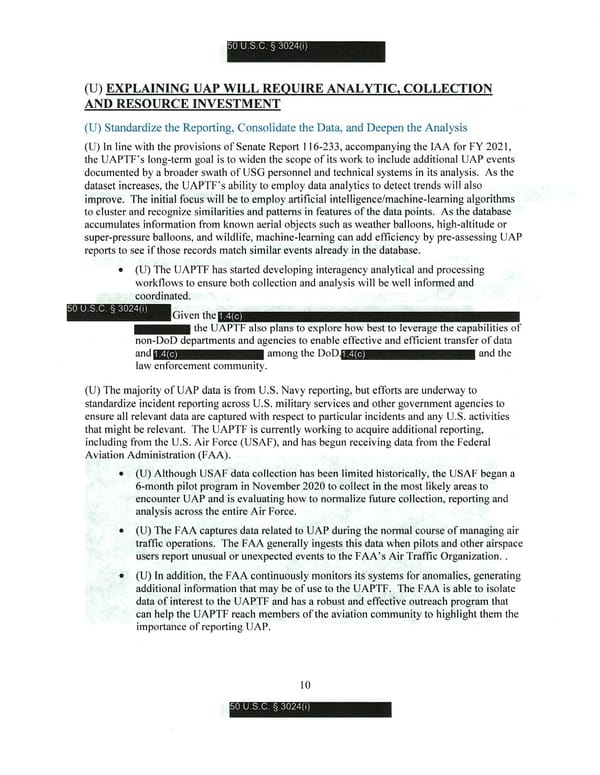50 U.S.C. § 3024(i) (U) EXPLAINING UAP WILL REQUIRE ANALYTIC, COLLECTION AND RESOURCE INVESTMENT (U) Standardize the Reporting, Consolidate the Data , and Deepen the Analysis (U) In line with the provisions of Senate Report 116-233 , accompanying the IAA for FY 2021 , the UAPTF ' s long-term goal is to widen the scope of its work to include additional UAP events documented by a broader swath of USG personnel and technical systems in its analysis. As the dataset increases , the UAPTF ' s ability to employ data analytics to detect trends will also improve. The initial focus will be to employ artificial intelligence/machine-learning algorithms to cluster and recognize similarities and patterns in features of the data points. As the database accumulates information from known aerial objects such as weather balloons , high-altitude or super-pressure balloons , and wildlife, machine-learning can add efficiency by pre-assessing UAP reports to see if those records match similar events already in the database. • (U) The UAPTF has started developing interagency analytical and processing workflows to ensure both collection and analysis will be well informed and coordinated. 50 U.S.C. § 3024(1) Given the 1.4( c) ••••• the UAPTF also plans to explore how best to leverage the capabilities of non-DoD departments and agencies to enable effective and efficient transfer of data and among the DoD and the 1.4(c) law enforcement community. (U) The majority of UAP data is from u.S. Navy reporting , but efforts are underway to standardize incident reporting across U.S. military services and other government agencies to ensure all relevant data are captured with respect to particular incidents and any U. S. activities that might be relevant. The UAPTF is currently working to acquire additional reporting, including from the U.S. Air Force (USAF) , and has begun receiving data from the Federal Aviation Administration (FAA). • (U) Although USAF data collection has been limited historically, the USAF began a 6-month pilot program in November 2020 to collect in the most likely areas to encounter UAP and is evaluating how to normalize future collection, reporting and analysis across the entire Air Force. • (U) The FAA captures data related to UAP during the normal course of managing air traffic operations. The FAA generally ingests this data when pilots and other airspace users report unusual or unexpected events to the FAA's Air Traffic Organization .. • (U) In addition , the FAA continuously monitors its systems for anomalies , generating additional information that may be of use to the UAPTF. The FAA is able to isolate data of interest to the UAPTF and has a robust and effective outreach program that can help the UAPTF reach members of the aviation community to highlight them the importance of reporting UAP. to 50 U.S.C. § 3024(i)
 Unidentified Aerial Phenomena | NI Report Page 16 Page 18
Unidentified Aerial Phenomena | NI Report Page 16 Page 18